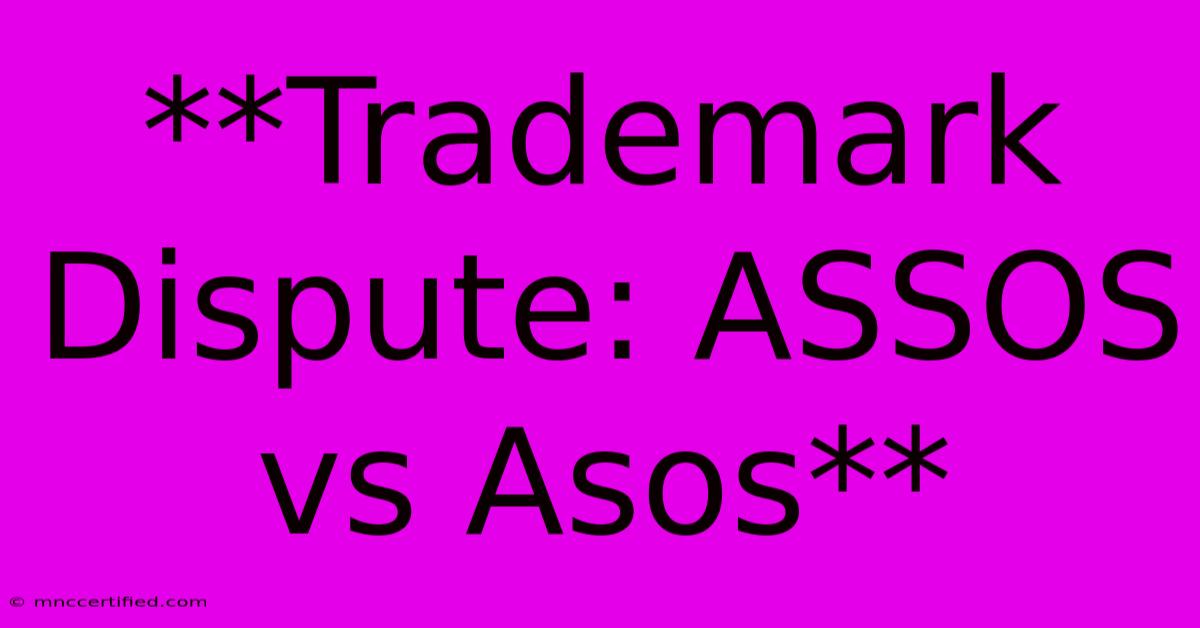**Trademark Dispute: ASSOS Vs Asos**

Table of Contents
Trademark Dispute: ASSOS vs ASOS – A Battle of the Brands
The world of fashion and high-performance cycling apparel witnessed a significant legal clash between two prominent brands: ASSOS of Switzerland, known for its premium cycling wear, and ASOS plc, the British online fashion retailer. This article delves into the intricacies of their trademark dispute, exploring the legal arguments, outcomes, and broader implications for brand protection in the global marketplace.
Understanding the Core of the Conflict
The conflict stemmed from a trademark dispute over the similar names: ASSOS and ASOS. While seemingly minor in difference, the similarity caused confusion among consumers and posed a significant threat to ASSOS's brand identity and market position. ASSOS, with its decades-long history of producing high-quality cycling apparel, argued that ASOS’s use of a similar name diluted its brand recognition and created potential for customer confusion.
ASSOS's Claims
ASSOS's primary argument revolved around the potential for trademark infringement and passing off. They claimed that ASOS's use of a similar name led to consumer confusion, causing customers to mistakenly associate ASOS's fashion offerings with ASSOS's premium cycling apparel. This, they argued, damaged their brand reputation and potentially impacted sales. They pointed to evidence of actual confusion among consumers, highlighting instances where customers contacted ASSOS believing they were contacting ASOS, or vice versa.
ASOS's Defense
ASOS, on the other hand, maintained that the two brands operated in distinct market segments and that there was minimal likelihood of consumer confusion. They argued that their brand identity, primarily focused on fast fashion, was significantly different from ASSOS's niche market of high-performance cycling apparel. Furthermore, they likely highlighted the difference in branding, logos, and target demographics to demonstrate a lack of overlap.
Legal Proceedings and Outcomes
The legal battle likely involved protracted negotiations, potentially including cease and desist letters, before reaching a courtroom. The specific details of the legal proceedings and the final outcome often remain confidential due to settlement agreements. However, we can deduce that the case likely centered on proving:
- Likelihood of confusion: The courts would have assessed the degree of similarity between the marks, the relatedness of the goods/services, and the sophistication of the relevant consumers.
- Strength of the ASSOS trademark: The strength of ASSOS's prior trademark registration and reputation would have been a key factor.
- ASOS's intent: Did ASOS intentionally choose a similar name to capitalize on ASSOS's reputation?
While the exact terms of any settlement are likely private, the outcome likely involved either:
- ASOS agreeing to modify its branding or cease using the ASOS name in certain markets.
- A financial settlement where ASOS compensated ASSOS for the damages caused by the trademark similarity.
- A dismissal of the case if ASSOS failed to prove sufficient grounds for infringement.
Lessons Learned for Brand Protection
The ASSOS vs. ASOS case serves as a crucial reminder of the importance of robust trademark protection for businesses of all sizes. Key takeaways include:
- Early trademark registration: Registering your trademark early in your business lifecycle is paramount to establishing exclusive rights and preventing future disputes.
- Comprehensive trademark searches: Before launching a brand, conduct thorough trademark searches to identify potential conflicts and minimize legal risks.
- Monitoring for infringement: Regularly monitor the marketplace for potential trademark infringements and be prepared to take swift action.
- Strong brand identity: A strong and distinctive brand identity can reduce the likelihood of confusion with other brands.
This case highlights the critical need for proactive brand protection strategies. While the specifics of the settlement remain undisclosed, the dispute underscores the potential costs and complexities associated with trademark conflicts, emphasizing the need for careful planning and legal counsel. The ASSOS vs ASOS case stands as a significant legal precedent in the fashion and sporting goods industries, influencing future brand protection strategies and highlighting the importance of vigilance in the competitive global marketplace.

Thank you for visiting our website wich cover about **Trademark Dispute: ASSOS Vs Asos**. We hope the information provided has been useful to you. Feel free to contact us if you have any questions or need further assistance. See you next time and dont miss to bookmark.
Featured Posts
-
Watch Mavericks Vs Jazz Tv Schedule
Nov 15, 2024
-
Earth Meta Crypto Price Prediction
Nov 15, 2024
-
Mavericks Vs Jazz Nba Predictions And Picks
Nov 15, 2024
-
Eva Longoria Family Relocates Amid Us Concerns
Nov 15, 2024
-
The Nature Of Covalent Bonding 8 2
Nov 15, 2024